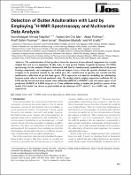Options
Detection of butter adulteration with lard by employing 1H-NMR spectroscopy and multivariate data analysis
Journal
Open Access
Journal of Oleo Science
Date Issued
2015
Author(s)
Fadzillah N.A.
Man Y.B.C.
Rohman A.
Rosman A.S.
Ismail A.
Mustafa S.
Khatib A.
DOI
10.5650/jos.ess14255
Abstract
The authentication of food products from the presence of non-allowed components for certain religion like lard is very important. In this study, we used proton Nuclear Magnetic Resonance (1H-NMR) spectroscopy for the analysis of butter adulterated with lard by simultaneously quantification of all proton bearing compounds, and consequently all relevant sample classes. Since the spectra obtained were too complex to be analyzed visually by the naked eyes, the classification of spectra was carried out.The multivariate calibration of partial least square (PLS) regression was used for modelling the relationship between actual value of lard and predicted value. The model yielded a highest regression coefficient (R2) of 0.998 and the lowest root mean square error calibration (RMSEC) of 0.0091% and root mean square error prediction (RMSEP) of 0.0090, respectively. Cross validation testing evaluates the predictive power of the model. PLS model was shown as good models as the intercept of R2Y and Q2Y were 0.0853 and ?0.309, respectively. � 2015 by Japan Oil Chemists� Society.
File(s)
Loading...
Name
Detection of butter adulteration with lard by employing 1H-NMR spectroscopy and multivariate data analysis.pdf
Size
686.27 KB
Format
Adobe PDF
Checksum
(MD5):789ce87d6a686c50e6a6c6c0defcd0e6